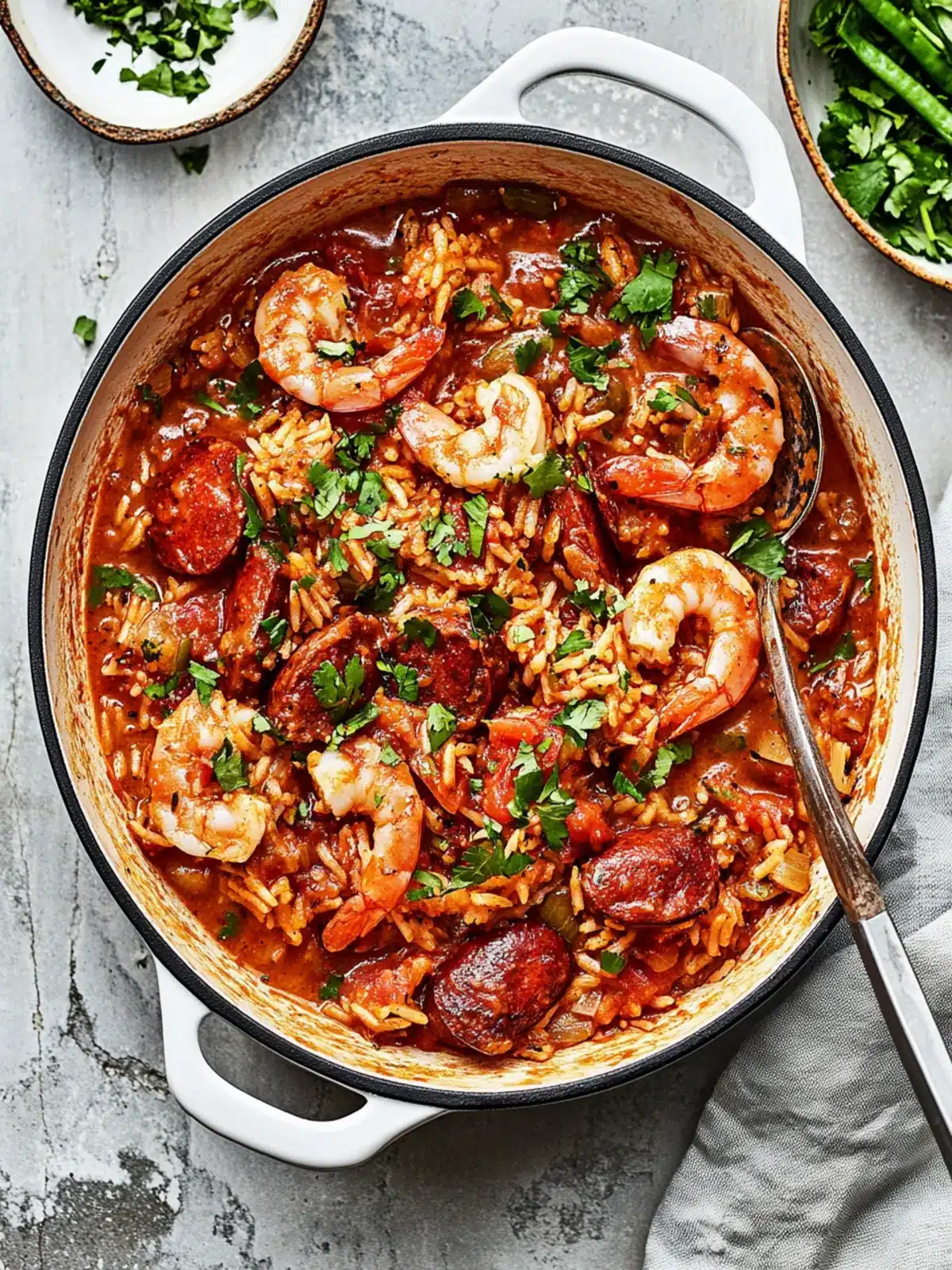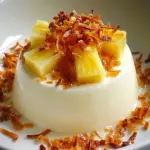There’s something soul-satisfying about a simmering pot of Jambalaya that transports me straight to the vibrant streets of New Orleans. The intoxicating blend of spices, tender chicken, and savory sausage meld together to create a dish that’s as comforting as it is exhilarating. I remember the first time I explored the depths of Cajun cuisine — the explosion of flavors in every bite awakened a passion for cooking that I never knew existed.
This recipe is my go-to when I crave a one-pot wonder that impresses friends and family alike, all while being surprisingly easy to prepare. With juicy shrimp diving into a bed of perfectly cooked rice, each serving is a celebration of comfort food that dances on the palate. Whether you’re dealing with a busy weeknight or planning a festive gathering, this Jambalaya fits the bill, blending richness and spice without overwhelming your day. Let’s dive into the details and get you started on this culinary adventure!
Why is Jambalaya the Ultimate Comfort Food?
Rich flavors burst from every ingredient, creating an unforgettable dish everyone will adore.
One-pot ease makes cleanup a breeze, letting you enjoy the meal without stress.
Crowd favorite: Friends and family will rave about its hearty goodness.
Versatile option: Customize with your favorite proteins and veggies for a personal touch.
Timeless recipe: This dish brings a piece of New Orleans to your kitchen, perfect for any occasion.
Sprinkle with fresh herbs for added freshness!
Jambalaya Ingredients
• Get ready to spice things up with these Jambalaya ingredients!
For the Base
- Extra-virgin olive oil – A staple fat for sautéing that adds a light flavor.
- Boneless skinless chicken thighs – Provides tender protein that absorbs flavor beautifully.
- Andouille sausage – This smoky sausage brings authentic Cajun flair to your dish.
- Cajun seasoning – Essential for that bold, spicy kick and rich flavor.
- Yellow onion – Adds sweetness and depth to the overall flavor profile.
- Green bell peppers – Their crunchiness adds texture and a subtle freshness.
- Celery – Contributes to the classic flavor base, enhancing the dish’s overall savoriness.
- Garlic cloves – Infuse the dish with their irresistible aroma and taste.
- Red pepper flakes – Adjust the heat to your liking for a personalized touch.
For the Rice Mixture
- Long grain white rice – The star of Jambalaya, absorbing flavors like a sponge.
- Bay leaf – Adds a subtle herbal note that enhances the dish’s complexity.
- Crushed tomatoes – Provides moisture and a touch of acidity to balance the richness.
- Low-sodium chicken broth – The flavorful liquid base that keeps everything juicy and tender.
For the Finish
- Large shrimp – Key to elevating the dish with a sweet, succulent contrast.
- Sliced green onions – A fresh garnish that brightens up every bite.
- Chopped parsley – Adds a splash of color and freshness right before serving.
Get ready to sway to the rhythm of flavor as you bring this Jambalaya dish to life!
How to Make Jambalaya
-
Toss chicken: In a medium mixing bowl, toss the bite-sized chicken pieces with 1 tablespoon of Cajun seasoning until they are evenly coated. This infuses the chicken with delicious flavor!
-
Sauté chicken: Heat 2 tablespoons of olive oil in a large Dutch oven or pot over medium-high heat. Add the seasoned chicken and sauté until it’s lightly golden and cooked through, about 6-7 minutes. Remove the chicken to a plate afterward.
-
Brown sausage: In the same pot, add the remaining tablespoon of oil along with the sliced andouille sausage. Sauté for around 3-4 minutes until the sausage is browned on both sides, then transfer it to the plate with the chicken.
-
Cook veggies: Add diced onion, bell peppers, and celery to the pan, sautéing for 4 to 5 minutes until they’re softened. Stir occasionally, adding more oil if required for a smooth cook.
-
Add garlic and spices: Stir in the minced garlic, remaining Cajun seasoning, and red pepper flakes. Cook for about 30 seconds, allowing the garlic’s aroma to enhance the dish.
-
Toast rice: Toss in the rinsed rice and toast it with the veggies and spices for 1 minute to develop flavor. Then, add the bay leaf, crushed tomatoes, and chicken broth. Stir well, bring to a simmer, then reduce the heat to low. Cover and cook for approximately 7 to 8 minutes, stirring occasionally to prevent sticking.
-
Combine everything: After removing the bay leaf, gently add the shrimp, along with the browned sausage and cooked chicken back to the pot. Stir carefully, cover, and turn off the heat, letting the shrimp cook through for 4 to 5 minutes while the rice absorbs the remaining liquid.
-
Garnish: Before serving, sprinkle with sliced green onions and chopped parsley to brighten up your dish.
Optional: Serve with a wedge of lemon for a zesty twist!
Exact quantities are listed in the recipe card below.
Make Ahead Options
These Jambalaya ingredients are perfect for meal prep! You can marinate the chicken with Cajun seasoning and sauté both the chicken and sausage up to 24 hours ahead of time, storing them in an airtight container in the refrigerator. The chopped vegetables (onions, bell peppers, and celery) can also be prepped and kept in the fridge for 3 days. When ready to enjoy your delicious Jambalaya, simply reheat the chicken and sausage with the sautéed vegetables in your pot, add the rinsed rice, tomatoes, and broth, and continue with the recipe as directed. This ensures you’ll have a hearty meal ready to serve during busy weeknights, all while maintaining the dish’s vibrant flavors!
How to Store and Freeze Jambalaya
Fridge: Store leftover Jambalaya in an airtight container for up to 3 days. Reheating in the microwave or on the stovetop will keep it delicious and warm.
Freezer: For longer storage, freeze Jambalaya in freezer-safe containers for up to 3 months. Thaw in the fridge overnight before reheating.
Reheating: When ready to enjoy, add a splash of chicken broth while reheating to prevent drying out. This will help restore its original moisture and flavor.
Room Temperature: If you’re serving Jambalaya at a gathering, it’s best to keep it at room temperature for no longer than 2 hours to ensure food safety.
What to Serve with Jambalaya?
Elevate your Jambalaya experience with delightful side dishes and complementing flavors that bring your meal to life.
- Remoulade Sauce: A tangy, zesty sauce that adds a creamy contrast to the spices in Jambalaya.
- Cornbread: This sweet, moist bread is the perfect accompaniment, soaking up the flavorful broth and adding a touch of comfort.
- Coleslaw: Crisp, refreshing slaw with a hint of sweetness balances the heat and richness of Jambalaya, making every bite a delight.
- Garlic Bread: Buttery, toasted garlic bread adds a satisfying crunch, perfect for sopping up every last drop of this savory dish.
- Green Salad: A light salad with mixed greens and a vinaigrette offers a refreshing palate cleanser to contrast with the robust flavors.
- Sangria: A fruity, refreshing drink, its sweetness and acidity complement the rich spices of Jambalaya, creating a harmonious dining experience.
Jambalaya Variations
Feel free to let your culinary creativity shine with these delicious twists on a classic Jambalaya recipe!
-
Spicy Chicken: Increase the Cajun seasoning to add an extra kick. If you love heat, consider incorporating jalapeños for an exciting flavor boost.
-
Vegetarian Delight: Replace meat with hearty vegetables like zucchini, mushrooms, and bell peppers. Use vegetable broth instead of chicken broth for a savory, plant-based option.
-
Seafood Medley: Mix in different seafood like crab or scallops for a seafood-packed Jambalaya that celebrates the ocean’s bounty. The combination of flavors creates an unforgettable dish.
-
Brown Rice: Swap long-grain white rice for brown rice for added fiber and nutty flavor. Just adjust the cooking time and liquid, as brown rice takes longer to cook.
-
Smoky Flavor: Add smoked paprika for an irresistible, smoky depth. This will elevate your dish to new flavor heights, enhancing the authentic Cajun essence.
-
Sweet Corn: Toss in fresh or frozen corn kernels for a touch of sweetness and extra texture. The sweetness beautifully balances the spices, creating a delightful contrast.
-
Herb Infusion: Incorporate fresh herbs like thyme or bay leaves during cooking for a fragrant aroma. The herb addition will create a lovely layer of flavor.
-
Hot Sauce: Serve with your favorite hot sauce on the side for those who enjoy a splash of additional heat. It allows everyone to personalize their spice level with each bite.
Expert Tips for Jambalaya
- Seasoning Matters: Ensure to season each layer of the dish as you cook. This builds a richer flavor profile for your Jambalaya.
- Rice Check: Rinse your long grain white rice thoroughly before adding. This helps remove excess starch and keeps it from becoming gummy.
- Don’t Rush the Shrimp: Add the shrimp at the end and allow carryover cooking. Turning off the heat will ensure it cooks through without becoming tough.
- Customizable Ingredients: Feel free to substitute proteins based on your preference; just maintain the balance of flavors for a proper Jambalaya experience.
- Let it Rest: Allow your finished dish to sit covered for a few minutes after cooking. This helps the rice soak up any stray liquids and improves texture.
Jambalaya Recipe FAQs
What kind of rice is best for Jambalaya?
I recommend using long grain white rice for the best texture and flavor absorption. It’s fluffy and cooks well with the rich broth. Avoid using short grain rice as it can become sticky, resulting in a less desirable consistency.
How do I select ripe vegetables for my Jambalaya?
For the best flavor, look for bell peppers that are firm with smooth skin and a vibrant color. Choose onions that feel heavy for their size and are free of dark spots. Fresh celery should be crisp with green leaves. When in doubt, pick the ones that feel the freshest!
How long can I store leftover Jambalaya?
Store it in an airtight container in the fridge for up to 3 days. It’s perfect for a quick lunch or dinner later on! When reheating, try adding a splash of chicken broth to restore moisture.
Can I freeze Jambalaya? What’s the best method?
Absolutely! Freezing is a great option. Allow the Jambalaya to cool completely before portioning it into freezer-safe containers. It can be frozen for up to 3 months. To thaw, simply move it to the fridge overnight. Reheat gently on the stove or microwave, adding a little broth if it seems dry.
What should I do if my rice is mushy after cooking?
If you find your rice has become mushy, it may be due to overcooking or too much liquid. Ensure to measure the broth accurately and check the rice frequently as it cooks. In future attempts, you might want to reduce the liquid slightly or decrease the cooking time.
Is Jambalaya safe to serve room temperature?
When serving at a gathering, it’s best to keep the Jambalaya at room temperature for no longer than 2 hours. This helps ensure food safety while still allowing guests to enjoy its flavors. If you’re unsure, serving it hot straight from the pot adds a delightful touch!

Savory Jambalaya: A Comforting Creole Delight Awaits You
Ingredients
Equipment
Method
- In a medium mixing bowl, toss the bite-sized chicken pieces with 1 tablespoon of Cajun seasoning until evenly coated.
- Heat 2 tablespoons of olive oil in a large Dutch oven over medium-high heat. Add seasoned chicken and sauté until lightly golden, about 6-7 minutes. Remove the chicken.
- In the same pot, add 1 tablespoon of oil and sliced andouille sausage. Sauté for 3-4 minutes until browned. Transfer to the chicken plate.
- Add diced onion, bell peppers, and celery to the pot. Sauté for 4-5 minutes until softened.
- Stir in minced garlic, remaining Cajun seasoning, and red pepper flakes, cooking for about 30 seconds.
- Add rinsed rice and toast for 1 minute. Then add bay leaf, crushed tomatoes, and chicken broth. Bring to a simmer, cover, and cook for 7-8 minutes.
- Remove the bay leaf, add shrimp, sausage, and chicken back to the pot. Cover and turn off heat, letting shrimp cook through for 4-5 minutes.
- Garnish with sliced green onions and chopped parsley before serving.








